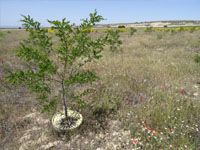Spain - LIFE+ The Green Desert, planting 63 hectares with trees
 There is a variety of interconnected issues related to the climate change impacts - these include increasing levels of CO2 in the atmosphere, traffic related emissions, soil degradation and subsequent loss of agricultural capacity and landscape, as well as loss of bio-diversity and eco-systems. One of the most devastating consequences of climate change is the desertification of areas that have previously provided important functions in terms of carbon sequestration, food production and landscape conservation. Tree planting, like this project in Spain, can help overcome these problems and innovative planting techniques are required to properly regenerate some degraded areas.
There is a variety of interconnected issues related to the climate change impacts - these include increasing levels of CO2 in the atmosphere, traffic related emissions, soil degradation and subsequent loss of agricultural capacity and landscape, as well as loss of bio-diversity and eco-systems. One of the most devastating consequences of climate change is the desertification of areas that have previously provided important functions in terms of carbon sequestration, food production and landscape conservation. Tree planting, like this project in Spain, can help overcome these problems and innovative planting techniques are required to properly regenerate some degraded areas.
Planting of trees at different locations in Spain
During the LIFE+ The Green Deserts project, carried out in collaboration with the European Commission Environment LIFE program, we have planted trees in Spain. In total, 63 hectares (all located in semi dry to very dry ares) was planted with trees while using the Waterboxx® plant cocoon. The trees were planted in the provinces Valladolid, Leon, Zamora, Zaragoza and Barcelona (see the map below – click on the trees and receive more information).
The objectives of the LIFE+ The Green Deserts project
The project's main objective is to demonstrate the feasibility and effectiveness of new tree planting techniques in desertified, poor and/or rocky areas. In this case, it will be the Waterboxx® plant cocoon. With the Waterboxx® plant cocoon trees will be planted to restore the sponge-function of degraded soils and reinforce soils' existing capacity for supporting plant life.
Other objectives of these projects are:
- Demonstrate the feasibility of cultivation of Hedera with the Waterboxx® plant cocoon, to facilitate its application for the capture of CO2 and fine powder alongside highways;
- To clarify on larger scale, with the novelties purposely developed to facilitate such scale, should clarify for which soils, trees and by which application methods the best results can be obtained for differentiated scopes like agriculture, reforestation and restoration of eco-systems;
- To offer sufficient proof of concept to be broadly disseminated to potential target groups, in order to pave the way for broad introduction of the technology in view of combating the disastrous effects of climate change on the natural environment.
The project has to demonstrate that it can on a realistic scale, on the 5 test locations, that the following goals can be achieved on the long term with the technology:
- Improvement of soils by stimulating the natural capacities of plants;
- Improvement of success rates of planting in eroded and desert areas to above 95%;
- Reconstruction of forests in desertified areas, capable of absorbing large amounts of our CO2 emissions;
- Restoration of desertified agricultural land to economic profitability, increasing the economic opportunities in rural areas and thus combating their abandonment
- Reduction of water and energy use, as the technology does not require any type of irrigation
- Reduction of fine powder and CO2 emissions by traffic, by facilitating planting of the always-green Hedera alongside highways
- Restoration of eco-systems facilitating the planting of indigenous and endangered species in desertified or otherwise damaged territories.
- Possibly planting all year round, offering long-term employment and larger time spans for cultivation and reforestation.
Actions
In order to proof the viability of the Waterboxx® plant cocoon on a demonstration scale and to assess its results, the project foresees planting of a variety of species on a variety of soil types in lots which range from bare land to mountains to a waste dump (a total of 63 Ha, all located in areas with a moderately dry to extremely dry climate).
In order to allow for a proper assessment control groups are foreseen. About half of the saplings will be planted in the first year, the other in the second, in order to compensate for ‘unrealistic’ results caused by a particularly wet year. Particular small saplings will be used (3 cm), which have bigger possibilities for growth on poor soil.
In order to test if with the Waterboxx® plant cocoon planting of these kind of saplings would be possible all year round, a small part will be planted in July. As the device has to be placed just below the soil, requiring a small hole, in order to avoid being blown away by the wind, the large scale application of it in dry and rocky areas requires a capillary drill. A prototype of such a drill will be developed in the project, and tested in the concerned areas.
Growth will be monitored for 3-4 years: after such period, a tree has passed the most critical part of its life-time and can be considered to have survived.
Results of planting trees in Spain with the Waterboxx®
Read the results of planting trees in Spain with the Waterboxx® plant cocoon below in the multiple reports and see the pictures of the plantings in the photo albums.
Reports of the Life+ The Green Deserts Projects in Spain
- Life+ report by the European Union
- Report of 'Los Desiertos Verde' for June 2011
- Report of 'Los Desiertos Verde' for March 2012
- Presentation of the University of Valladolid in March 2012 for 'Los Desiertos Verdes'
- Expected results and objectives for October 2012 by the University of Valladolid
- Report of 'The Green Desert Project' for October 2013 written by the University of Valladolid
Photo series and video's of the LIFE+ The Green Deserts Projects in Spain
More information about planting trees in Spain
Do you want to plant trees with the Waterboxx® plant cocoon in Spain or somewhere else? Go to our shop and order a 10-pack Waterboxxes. Do you want to know more about this project? Go to the website of The Green Deserts!















